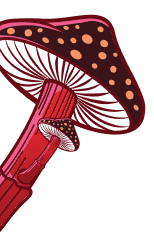Reishi mushrooms, also known as Lingzhi mushrooms, are a type of medicinal fungus that has been used in traditional Chinese medicine for thousands of years. These mushrooms are highly regarded for their numerous health benefits and are prized for their adaptogenic properties. In this comprehensive guide, we will explore everything you need to know about cultivating reishi mushrooms at home.
Understanding Reishi Mushrooms
Before you embark on your journey to cultivate reishi mushrooms, it is important to have a solid understanding of these unique fungi. Reishi mushrooms belong to the Ganoderma genus and are characterized by their distinctive fan-shaped caps and woody texture. They come in various colors, ranging from red to black, and have a bitter taste.
The Health Benefits of Reishi Mushrooms
Reishi mushrooms are renowned for their remarkable health benefits. They are rich in bioactive compounds such as polysaccharides, triterpenes, and antioxidants, which contribute to their therapeutic properties. Some of the key health benefits associated with reishi mushrooms include:
- Boosting immune function: Reishi mushrooms have been found to enhance immune cell activity, making them effective in fighting infections and diseases.
- Reducing inflammation: The anti-inflammatory properties of reishi mushrooms can help alleviate symptoms of chronic inflammation and related conditions.
- Promoting heart health: Studies suggest that reishi mushrooms may help lower blood pressure, and cholesterol levels, and reduce the risk of heart disease.
- Supporting liver function: Reishi mushrooms have traditionally been used to support liver health and promote detoxification.
The History and Origin of Reishi Mushrooms
Reishi mushrooms have a long history of use in traditional Chinese medicine, dating back over 2,000 years. They were highly prized by emperors and believed to confer immortality. Reishi mushrooms were traditionally found in the wild, growing on decaying tree trunks. Today, they can be cultivated in controlled environments, allowing for home cultivation.
Legend has it that the discovery of reishi mushrooms was accidental. It is said that a Chinese emperor while exploring the forests, stumbled upon a decaying tree trunk covered in these peculiar mushrooms. Intrigued by their unique appearance, he decided to take them back to his palace for further examination. Little did he know that this chance encounter would lead to the discovery of a powerful medicinal treasure.
Over the centuries, the popularity of reishi mushrooms spread beyond the royal courts and into the homes of the common people. Traditional Chinese medicine practitioners recognized the mushrooms' potential to promote overall well-being and restore balance in the body. They were used to treat a wide range of ailments, from respiratory issues to fatigue and stress.
As the demand for reishi mushrooms grew, so did the interest in cultivating them. In the past, finding wild reishi mushrooms was a challenging task, as they were rare and only grew in specific environments. However, with advancements in technology and agricultural practices, it is now possible to cultivate reishi mushrooms in controlled environments, ensuring a steady supply of these valuable fungi.

Preparing for Mushroom Cultivation
Before you start cultivating reishi mushrooms at home, there are a few essential steps you need to take to ensure success.
First and foremost, it's important to gather all the necessary equipment for growing reishi mushrooms. Let's take a closer look at what you'll need:
Necessary Equipment for Growing Reishi Mushrooms
Here is a list of the necessary equipment you will need for growing reishi mushrooms:
- Spawn: This is the mycelium culture of the reishi mushroom that will be used to inoculate the growing medium. It's like the "seed" for your mushrooms, providing the necessary nutrients for growth.
- Growing containers: Choose containers that have good drainage and are suitable for mushroom cultivation. Plastic containers or trays with holes for proper airflow are commonly used.
- Growing medium: Reishi mushrooms thrive on hardwood sawdust, supplemented with wheat bran or rice bran. This combination provides the ideal nutritional composition for the mushrooms to flourish.
- Water mister: Use a misting bottle to keep the growing medium moist but not soaked. Reishi mushrooms prefer a humid environment, and misting helps maintain the necessary moisture levels.
- Plastic bags or covers: These will help create a humid environment during the incubation period. Simply cover the containers with plastic bags or use plastic covers to trap moisture and create the perfect conditions for mushroom growth.
- Thermometer and hygrometer: Monitoring the temperature and humidity levels is crucial for mushroom growth. These tools will allow you to keep a close eye on the environmental conditions and make any necessary adjustments.
- Grow lights (optional): If you don't have access to natural light, grow lights can be used to provide adequate illumination. Reishi mushrooms don't require intense light, so low-intensity artificial light can be sufficient.
Now that you have all the necessary equipment, it's time to create the ideal conditions for reishi mushroom growth.
Ideal Conditions for Reishi Mushroom Growth
Reishi mushrooms require specific environmental conditions to thrive. Here are the ideal conditions for reishi mushroom cultivation:
- Temperature: Reishi mushrooms prefer a temperature range between 20-25°C (68-77°F). This temperature range provides the optimal conditions for mycelium growth and mushroom development.
- Humidity: The humidity level should be kept around 70-80% during the incubation period and reduced to 50-60% during fruiting. Maintaining proper humidity is crucial for the mushrooms to absorb moisture and grow successfully.
- Light: Reishi mushrooms require indirect sunlight or low-intensity artificial light. Exposing them to direct sunlight can be harmful, so it's best to provide them with gentle, diffused light sources.
- Air circulation: Proper air circulation is essential to prevent the growth of contaminants and ensure healthy mushroom development. Make sure there is enough airflow in the growing area to keep the mushrooms fresh and free from unwanted intruders.
By following these guidelines and providing the necessary equipment and ideal conditions, you'll be well on your way to cultivating your reishi mushrooms at home. Remember, patience and attention to detail are key to a successful harvest!
The Cultivation Process
Now that you are familiar with the equipment and ideal conditions, let's dive into the cultivation process for reishi mushrooms.
Reishi mushrooms, also known as Ganoderma lucidum, have been revered for centuries for their potential health benefits. Cultivating these mushrooms at home can be a rewarding experience, allowing you to enjoy their unique flavor and medicinal properties.
Steps to Inoculate Your Reishi Mushrooms
The first step is to prepare the growing medium. Mix hardwood sawdust with wheat bran or rice bran and sterilize it to eliminate any competing organisms. This process helps create a nutrient-rich environment for the reishi mushrooms to thrive. After the growing medium has cooled, transfer it to the growing containers.
Next, obtain the reishi mushroom spawn. Break the spawn into small pieces and distribute them evenly throughout the growing containers. The spawn serves as the starting point for the growth of the mushrooms, providing them with the necessary mycelium to colonize the substrate. Cover the containers with plastic bags or covers to create a humid environment, mimicking the natural conditions that reishi mushrooms prefer.
It's essential to place the containers in a warm and dark location for the incubation period. Maintain the desired temperature and humidity levels, misting the growing medium as needed to prevent it from drying out. After a few weeks, white mycelium should start to colonize the growing medium, indicating that the mushrooms are establishing themselves.
Monitoring and Maintaining Your Mushroom Growth
Once the mycelium has fully colonized the growing medium, it's time to initiate fruiting. Remove the plastic bags or covers and place the containers in a well-ventilated area with indirect light. This change in environment signals to the mushrooms that it's time to transition from mycelium growth to fruiting body development.
Throughout the fruiting stage, continue monitoring the temperature, humidity, and air circulation. These factors play a crucial role in the successful development of reishi mushrooms. Mist the mushrooms with water regularly to maintain proper moisture levels, ensuring that the growing environment remains conducive to fruiting. Over the next few weeks, you will witness the mushroom caps starting to develop, eventually reaching maturity as they continue to grow and expand.
Harvesting Your Reishi Mushrooms
Knowing when to harvest your reishi mushrooms is crucial for obtaining optimal flavor and potency.
Identifying When Your Reishi Mushrooms Are Ready to Harvest
Reishi mushrooms are typically harvested when the caps have fully expanded and become firm to the touch. The color may vary depending on the species, but they should have a glossy appearance and visible pores on the underside.
It is important to harvest reishi mushrooms before the spores are released, as this can impact the flavor and quality of the mushrooms.
How to Properly Harvest and Store Your Reishi Mushrooms
To harvest reishi mushrooms, gently twist or cut the stems close to the growing container. Avoid damaging the surrounding mycelium during the process.
After harvesting, it is best to use the mushrooms fresh. However, if you have excess mushrooms, they can be stored in the refrigerator in a paper bag for up to two weeks. Alternatively, you can dry the mushrooms by placing them in a well-ventilated area until they become brittle.

Utilizing Your Homegrown Reishi Mushrooms
Now that you have successfully cultivated your reishi mushrooms, it's time to reap the benefits by incorporating them into your daily routine.
Preparing Reishi Mushrooms for Consumption
Reishi mushrooms have a tough and woody texture, making them unsuitable for direct consumption in their raw form. The best way to enjoy their health benefits is by preparing them as tea or extracts.
To make reishi mushroom tea, simmer dried or fresh mushrooms in water for at least an hour. You can then strain the liquid and add honey or other sweeteners to taste. Alternatively, reishi extracts are available in the form of powders, capsules, or tinctures, which can be easily incorporated into your wellness routine.
Preserving Your Reishi Mushrooms for Future Use
If you have a surplus of reishi mushrooms, it is a good idea to preserve them for future use. Dried reishi mushrooms can be stored in airtight containers in a cool, dark place for up to a year. You can also grind them into a fine powder to use as a natural supplement or to enhance the flavor of soups, stews, and other dishes.
Conclusion
Cultivating reishi mushrooms at home is a rewarding and fulfilling journey. By understanding the basics of mushroom cultivation and providing the ideal conditions, you can enjoy the numerous health benefits of these remarkable fungi. Whether you choose to consume them in tea form or incorporate them into your cooking, reishi mushrooms are a valuable addition to your wellness routine. Incorporate a gummy into your routine too with those offered by Melting Forest.













